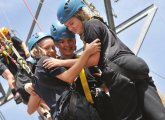Alack of social skills can be detrimental to a student’s self-esteem, self-determination and success at school and in life. But how can you can tell if a ‘shy’ student is merely introverted, or if there are deeper psychological roots for their lack of peer interaction? And is there anything wrong with introversion itself?
Despite an inherent pressure within society to be extroverted, introversion isn’t a bad thing – in fact, around 33-50% of the population are introverts. This isn’t immediately obvious, however, because in order to survive in a society that demands we be outgoing, sociable and gregarious, these ‘moths’ have succeeded in acting the part of the ‘butterfly.’ It is important for teachers to be aware, however, that it isn’t necessary to turn moths into butterflies, but to identify whether a child is a natural introvert or truly lacks social skills.
Introversion differs from shyness. An introverted person is happiest in a minimalistic environment with few distractions, while a shy child may be craving the frenetic pace of the extrovert but feels unable to gather the courage to get out there and participate. Introversion need only be of concern when deeper psychological issues are at play. A key indicator of a problem or need for intervention is a total lack of peer interaction.
Very often it is teachers who can spot problems with children’s social interactions. Parents can be too close to be able to step back and see how their child interacts, particularly in the case of teenagers, who often cut themselves off from adult contact. Parents can also be consumed with their own relationships, earning a living and making sure their children are properly fed and dressed, which may cause them to overlook a child who is a ‘moth’ – fluttering around in the dark, attracted to other children who radiate energy and confidence but never really able to achieve this for themselves.
Teachers in the front line
Jeanie Beales, an English teacher at a large girls’ school, says assessing whether there are deeper problems going on for a quiet student comes down to listening, and reading student writing carefully. Often, learners will share their personal thoughts or any problems through the medium of creative writing. “I have read essays, thinly disguised as fiction, that discuss problems such as cutting, bulimia, pregnancy, emotional abuse, and bullying,” she says, “all of which can also manifest in social isolation.” While teachers are not counsellors, they can listen or provide expressive outlets for the more isolated student.
Beales believes affirmations work wonders in helping quieter students to come out of their shell. “If a student does a fairly good piece of creative writing I believe in affirmation, affirmation, and more affirmation,” she explains. “Once they realise they have something of value to share, they become more confident in face-to-face situations. Sitting with a student to discuss their writing one-to-one makes a world of difference.”
She adds, “Parents can engage their children through stories or reports online or in newspapers to develop critical thinking skills. I feel there is often a lack of discussion, which doesn’t allow for drawing out what the child really feels. Once they are confident in sharing their views and attitudes with family members they will be better able to contribute to discussions at school.”
Be a good listener
If a student is withdrawn, it is worth observing whether bullying might be taking place since this can make students feel too inadequate to interact with others. Gentle probing can often get to the base of such problems, and this can be the beginning of a student feeling ‘heard’ – they have a voice. “A teenager was telling me her whole mixed-up history,” recalls Beales, “involving stepmothers and stepfathers, and eventually a move to a stepdad and his new wife, when she suddenly stopped herself and said, ‘I really don’t know why I am telling you all this,’ but promptly carried on with the saga. She just needed someone to hear her story and understand her.”
Kyle Schwartz, a teacher from Denver, Colorado, initiated a note-writing exercise called ‘I wish my teacher knew…’ to encourage students to open up to their teachers with their problems. Some of the resulting notes are poignant: a child who is being bullied; one who just wants one friend; another who doesn’t have pencils.
Developing social skills
Tatjana Glogovac, Mentor at the Regional Centre for Talents in Belgrade, comments “One way social skills can be developed in students is through group work and projects in which they need to interact with their peers in discussions of books in order to reach a mutual conclusion. This gets the more quiet ones to speak their minds and explain their viewpoints.”
She adds, “Another way is through creative tasks, where students can simply relax, get into this creative mood together and make group art projects, for example. When I teach a new grammar construction I normally have the students stand up and practise the new material in the form of dialogues with at least five partners; once they are finished with one partner they approach someone else. I think it is this act of approaching and starting a conversation that breaks the ice for the more quiet ones.”
It is important for teachers to take into account that many introverts have vast amounts of talent and are happy to work quietly on developing these. “When a group work project is announced some children inform me that they prefer to work alone even if it means a lot more effort,” confirms Beales. “Usually these are high achievers who are not satisfied with a mediocre end product and want to control each step of the process.”
The question that has preoccupied teachers for centuries is whether to focus on improving students’ weaknesses or strengthening their existing competences. Instead of thinking about introverts’ ‘weak points’, we can help them thrive in the areas where they feel most comfortable. Introverts enjoy reflective assignments; anything that motivates them to contemplate. They feel strongest in their own worlds and that is why teachers should allow them to create magic there. In today’s society, where everyone is focused on networking and making connections, teachers can easily forget that there are other ways of being and that they are perfectly acceptable too.
Moths and butterflies each have their place in nature, as do introverts and extroverts – the trick lies in making sure that the introverts are well-adjusted and that any underlying problems are identified early through observation of their behaviour, as well as careful attention to what they say and write.
Five tips for integrating a shy child Counselling psychologist sacha griffiths suggests the following:
• encourage interaction through questions and oneto- one time, e.g. “would you be able to explain this to me?” or “could we meet in the library to work on this together?”
• praising students for what they do well will build their self-esteem, enabling them to work on other areas that need development. many adolescents feel totally useless until someone points out their good points. once their self-esteem improves they will become more confident in approaching others.
• instead of group work, where a student may risk being ostracised, teachers and parents can initiate pair work, allowing for one-on-one interaction.
• don’t push students into situations – let them warm up slowly and do things in their own time.
• be sensitive to students’ interests and feelings. chat with them about themselves, and draw them out rather than simply writing off an interest as weird. once you have listened you can work on building confidence.
About the Author
Nicola Davies is a psychologist and freelance writer with a passion for education. you can follow her on twitter (@healthpsychuk) or sign up to her free blog: http://healthpsychology consultancy.wordpress.com/










